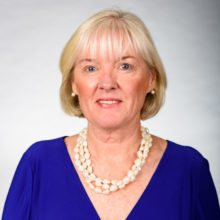
If you don’t know to look for something, you’re unlikely to find it. When that something is a rare disease, not finding it means patients endure years of inaccurate diagnoses and ineffective treatments, as well as the psychological trauma brought on by hopelessness. While they wait, their disease worsens.
Disease awareness campaigns help patients and physicians alike finally give symptoms a name, which is the first step in developing a therapeutic response.
 “Awareness campaigns can be really impactful in terms of enabling accurate, timely diagnosis,” Mary McGowan, executive director of The Myositis Association, says. “Patients need to know their symptoms—rashes, fatigue, trouble rising from chairs, falling, or the inability to open jars, for example—aren’t just signs of aging. When made aware of the symptoms and the fact that they can be part of a serious disease, people are more likely to discuss them with their doctors.”
“Awareness campaigns can be really impactful in terms of enabling accurate, timely diagnosis,” Mary McGowan, executive director of The Myositis Association, says. “Patients need to know their symptoms—rashes, fatigue, trouble rising from chairs, falling, or the inability to open jars, for example—aren’t just signs of aging. When made aware of the symptoms and the fact that they can be part of a serious disease, people are more likely to discuss them with their doctors.”
The Myositis Association launched its first national awareness campaign under McGowan’s new leadership, in May 2019. It’s too recent to have conclusive results, but McGowan already considers it a great success. “If we look at the outcomes of awareness campaigns for other diseases—breast cancer, for instance—we see that awareness leads to earlier detection.”
Elements of an effective campaign
The key to a successful awareness campaign is knowing what you are focusing on to reach your goal. For us, it was targeting those with the highest prevalence of the disease and those most affected by the awareness information, McGowan says. Initially, “Know who you’re targeting and why you’re targeting particular groups. Establish a direction, structure, and goals for the campaign, along with metrics to measure outcomes. Then you can begin to identify the most appropriate audiences and partners for the campaign.
“For myositis awareness month, we focused on general awareness,” McGowan begins. “We targeted physicians and the most likely patient population—women of color, the population that has the highest prevalence of both dermatomyositis and polymyositis— for a Women of Color and Myositis Awareness Campaign.”
Working with the National Institutes of Health, The Myositis Association created an infographic highlighting statistics regarding women of color and myositis. “It discussed how they were affected and listed, in layman’s terms, the most important things they should know to have a clear understanding of the disease.”
Then, McGowan and her team segmented that information for targeted activity, including social media posts, a national press release, a video highlighting a patient’s story, wall board graphics, and an educational webinar with physician experts focusing on women of color and myositis.
To increase awareness, The Myositis Association leveraged its 42 support groups throughout the US, its 10,000 member database, and the databases of patient advocacy organizations with which it partnered. The organization also provided op-eds in some patients’ communities. “Sharing their personal stories raises awareness and empowers others,” she emphasizes.
Before the campaign, the association worked with its patient advisory council (which includes a dozen African-American women) to ensure the material was effective for that community. “There were a variety of arms to the campaign. That’s important,” McGowan says.
“The social media activity was particularly impactful,” she continues. “We used a visual with a strong message each week, targeting not just Facebook and LinkedIn, but also specific physician groups and physician assistant groups. Analysis showed that much of the information was new, even to physicians. That shows we’re making a significant difference at both the clinician and patient level.”
The Myositis Association also leveraged connections with related, cross-over medical and patient organizations. For instance, patients with myositis also may have lupus or Sjogren’s syndrome, so collaborating with the National Organization for Rare Diseases or specific rare disease patient organizations to spread the message is a win-win.
Biopharma’s role
Biopharmaceutical companies’ roles in disease awareness campaigns are primarily financial. The Myositis Association’s biopharma partners, for instance, provided generous financial support, but did not oversee the development or content of the educational materials. “They also helped us amplify the message by sharing the materials through their own social media and employee networks,” McGowan adds.
The benefits accrue beyond simple good will. For drug developers, increased awareness of specific rare diseases extends the patient pool, which makes clinical trial recruitment easier. Myositis affects 50,000 to 75,000 people in the U.S., but other rare diseases affect far fewer individuals. For them, awareness campaigns are even more important.
Rare disease awareness campaigns have national healthcare financing benefits, too. It typically takes 3.5 years and five physician visits to accurate diagnose myositis. Awareness enables early diagnosis, which helps physicians avoid years of trial-and-error prescriptions and, often, patient depression. “Women are 50 percent more likely to suffer from depression before a diagnosis or health event,” McGowan says. “They’re also 50 percent more likely to experience depression after a health event or being diagnosed with a chronic disease, so there are ripple effects that may affect their jobs, ability to travel, and overall productivity.”
Awareness avoids many of these challenges, helping physicians address rare, difficult-to-diagnose conditions before they escalate into more serious (and more resource-intensive) disorders. Clearly, the benefits of awareness campaigns, especially for rare diseases, are far-reaching.
To explore multiple perspectives on disease awareness campaigns, join Mary McGowan in Boston June 13–14 for the Rare Disease Summit panel discussion, “The Role of Disease Awareness Campaigns for Rare Diseases.”
About The Author

Gail Dutton
Journalist
Gail Dutton is a veteran journalist who has interviewed several Nobel laureates as well as leading innovators in the fields of biotechnology, IT, and business. She has written for a variety of trade and consumer magazines, including Genetic Engineering & Biotechnology News, Life Science Leader, Forbes, Entrepreneur, The Scientist, Data Center Knowledge, and Data Center Manager, from her office in Washington state.